博物馆案例分析英文
小型博物馆案例分析(第三组

杂志楼建成于1805年,最早是一座军火库。它包括两个砖筑拱形弹药存储空间和一个较低的方 形围合柱廊。该建筑一直用作军火相关的用途,直到1963年。之后,被皇家公园用作仓储空间。杂 志楼直到最近才进入改造阶段。随着时间的流逝,历史建筑自身和周围环境都发生了较大的改变。
夜景
扩建部分包含一个开敞的公共空间,我们希望能够作为一个新的文化目的地和餐饮空间。 扩建部分作为对古典石构建筑的补充,展现了一种灵动、透明的21世纪现代空间。新旧空间形 成了一种强烈对比。
Archeological Space in Daroca / Sergio Sebastián Franco
入口
会议大厅
Archeological Space in Daroca / Sergio Sebastián Franco
从外面能直接看到博物馆内部
Archeological Space in Daroca / Sergio Sebastián Franco
场地关系
Байду номын сангаас
Vucedol 文化博物馆地址选在一个高差达到20米 的坡地上,与地形相契合,面向对面的多瑙河。 所有的功能排布呈阶梯状,成为一条路径联系坡 底与坡上的考古遗址平台。 大部分埋于地下,只有正立面向景观开放。蜿蜒 的屋顶做成绿色屋顶融入景观。
展览方式
1.了解其展示内容,及文物类别,大小。
2.总结出每个厅的故事线,故事线则是 这个展厅的脉络。
杨子媛 白雪玲
Archeological Space in Daroca / Sergio Sebastián Franco
Archeological Space in Daroca / Sergio Sebastián Franco
博物馆设计案例分析

博物馆设计案例分析
1. 大英博物馆(The British Museum)
2. 目标博物馆(Museum of Tomorrow)
目标博物馆位于巴西里约热内卢,其设计以可持续发展为主题。
博物
馆外形独特,像一艘飞船,象征着未来的探索和科技发展。
建筑外墙覆盖
了太阳能板,通过收集和利用太阳能为博物馆供电。
内部空间采用大面积
的玻璃幕墙,提供了充足的自然光线,同时采用智能控制系统进行能源管理。
展厅中用到了虚拟现实和互动技术,增加了观众的参与感和体验感。
3. 图卢兹宇宙城市航天博物馆(Cité de l'espace)
图卢兹宇宙城市航天博物馆位于法国图卢兹,是一个以航天和宇宙为
主题的科普场馆。
博物馆的外形像一个巨大的球体,象征着地球和宇宙。
建筑内部分为不同的展厅,展示了太空探索的历史、技术和未来发展。
展
品之间通过透明的玻璃墙隔开,可以清晰地观察到宇宙飞船和太空模型。
博物馆还设有模拟飞行和太空漫步等互动体验项目,为观众带来身临其境
的体验。
这些博物馆设计案例的共同特点是注重展品的陈列和空间的创意布置,将建筑和展览融为一体,提供了丰富的学习和体验机会。
同时,博物馆设
计也注重环境可持续性和能源管理,运用先进的技术手段优化能源利用。
这些设计理念体现了博物馆作为一个教育和文化交流场所的使命和责任。
博物馆设计案例解析
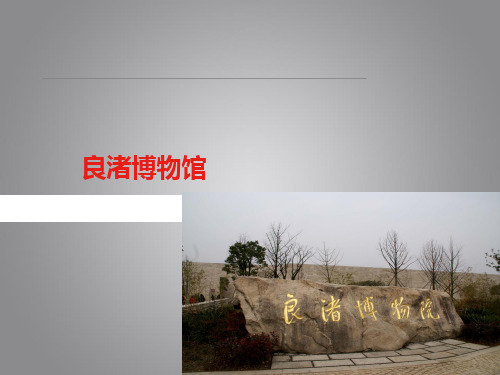
请在此输入您的标题
请在此输入您的副标题
托莱多艺术博物馆
托莱多艺术博物馆
• 地点:美国,俄亥俄州 • Toledo客户:托莱多艺术博物馆(Toledo Museum of Art) • 建筑师:妹岛和世+西泽立卫 / SANAA • 设计组:Toshi Oki, Takayuki Hasegawa, Keiko
展馆的平面来自于根据功能设定 的直线网格。在房间的连接处使 用了弯曲的玻璃。围合房间的玻
• 建筑本身的特点是跟整个公园的融合, 而整个公园的特点是水.整个博物馆建 造在一个人造的地形上, 而这块人造地形也经过了人为的雕塑, 专为访客规 划了一条景观通道和步行途径, 而交通工具则另辟了一条桥梁式通道直通停 车场和入口的庭院.
• 设计特点 • 内外空间和功能设计: 博物馆依山面水,在建筑样式上,既体现了当代先
这个玻璃大厅既是博物馆玻 璃藏品的展示空间,也是玻 璃制作工坊。设计构思是在 单层空间内布置几个庭院, 视线可以穿过多层玻璃墙, 这样参观者可以感到一直处 于周围的绿荫环抱中。各个 空间由玻璃围合而成,所形 成的内凹可以起到不同环境 的过渡区作用,如展览空间、 玻璃工坊和室外区域。
著名诗人保罗·史克尔巴特(PaulScheerbart)有过一句名言说"文化 是建筑的产物"。他曾经在一个世纪前向往过能带来"文化灵感"的玻 璃房子,"如果有一座玻璃宫殿,人生没有负担。"站在全新的托莱多 艺术博物馆门前,这座大玻璃房子让人惊叹,史克尔巴特臆想中的玻 璃魅影,被真实地显现出来。
平面分析第一展厅?发现求真?平面图第二展厅?良渚古国?平面图第三展厅?良渚文明?通过三个平面图可以看出良渚博物馆内部展厅的路线并不是普通的直线而是有很多的曲折而且各个展厅大体是串联的这样既节约了空间又在一定程度上通过隔墙展品阻碍了视线让游客对下一步会遇到什么样的展品充满期待趣味横生
建川博物馆各馆案例分析

It is applicable to work report, lecture and teaching
博物馆简介
建川博物馆聚落由樊建川先生创建, 坐落于国家级历史文化名镇四川成都安 仁古镇,占地500亩,现已建成开放18座 博物馆,共收藏文物800余万件,其中国 家一级文物件。为中国最大的博物馆聚 落。
博物馆采用圆、方、十字形 等典型的古典平面,营造神圣空 间。材料均采用文革时期通用的 清水红砖,以表现单一、极端、 纯粹、狂热的特殊时代氛围。
民俗博物馆系列
喜文化陈列馆 老公管家具馆 百年老照片陈列馆 精美笔筒陈列馆 老烟具赌具馆 三寸金莲文物馆 老七十二行馆等分馆
刘文辉旧居陈列馆
刘文辉旧居陈列馆: 刘文辉公馆建于1938年,落成于1941年,占地面积24882平方米, 建筑面积8406平方米,房屋162间。整个公馆建筑呈正方形,分为南北两个部分,每道大 门进去的建筑布局基本一致,中间由花墙间隔,既互相联系,又独立成章。刘文辉公馆既 有封建豪门府邸的遗风,又ห้องสมุดไป่ตู้西方城堡和教堂建筑的特色。
红色年代系列
瓷 器 陈 列 馆(已 开 放 ) 生活用品陈列馆(已开放) 章钟印陈列馆 宣 传 画 陈列馆 票 证 陈列馆 镜 鉴陈 列 馆 音 像 品 陈 列馆
文革瓷器陈列馆
博物馆建筑面积 5000平方米,一层展厅 顶面构成了二层展示平 台,提供了和底层封闭 展厅完全不同的开敞性 展示空间。
一层平面图
川军馆的结构体系是将结构模 型与空间形式紧密相关。每一个7 5m x 7 5m的天井都用钢筋混凝土 剪力墙围合,剪力墙两侧出挑4 5m 形成二层展厅。这样的一个结构单 元体间隔7 5m重复排列,每两个结 构单元体之间用钢筋混凝土板连接 成平台,在平台上放置木结构的坡 顶构架,形成另一组展览空间。
博物馆案例分析范文

博物馆案例分析范文
案例1:大英博物馆(The British Museum)
第三,大英博物馆还注重与观众的互动和教育。
它提供丰富的讲解解
说和导览服务,帮助观众深入了解每个展品的意义和历史背景。
此外,博
物馆还举办一系列主题展览、讲座和互动活动,使观众积极参与进来,并
且将知识变得更具趣味性和亲民性。
最后,大英博物馆的免费入场也在一定程度上促进了其成功。
免费入
场政策使更多的人有机会参观博物馆,提高了文化和艺术的普及率。
此外,大英博物馆还有一个出色的礼品店和咖啡厅,为游客提供购物和休息的场所。
案例2:纽约现代艺术博物馆(Museum of Modern Art, MoMA)
纽约现代艺术博物馆是一个专注于现代和当代艺术的博物馆,他们的
成功主要归因于以下几个方面。
首先,纽约现代艺术博物馆的良好地理位置为其成功做出了贡献。
它
位于纽约市中心曼哈顿地区的一个繁忙的旅游区,这使得它容易被游客找
到并方便观览。
第三,纽约现代艺术博物馆的展览方式也为其成功做出了贡献。
它将
展览分为不同的主题和时期,使观众能够更好地理解艺术作品的发展和意义。
此外,博物馆还定期举办世界各地的巡回展览,进一步丰富了观众的
艺术体验。
最后,纽约现代艺术博物馆非常注重与观众的互动和教育。
它提供多种教育计划和活动,包括讲座、工作坊和社区项目等。
这些活动和项目使博物馆能够更好地与观众互动,促进他们对艺术的理解和欣赏。
博物馆案例分析-英语
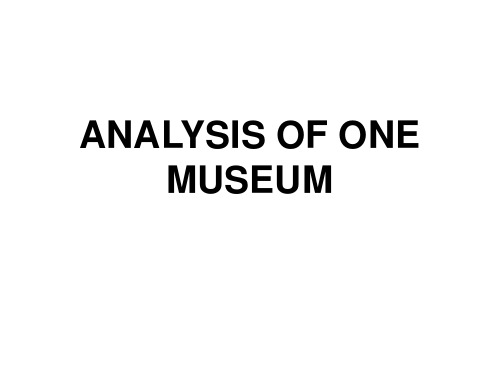
sceneries in the sight line outside
sceneries in the sight line around the atrium
Analysis of Light
Brief summary: 1 Lighting through skylight in the atrium and sidewindows makes light distributing in all the floors,especially in the underground ones. 2 It adopts baffles when lighting through skylight,which accords with functions. 3 Light is distributing differently in different floors or rooms, making inner space more interesting.
Analysis of Site
active scenes on the square between the old and new buildings
ห้องสมุดไป่ตู้
Analysis of Flow Line
Brief summary: 1 Office occupancy and other accessories are underground, while the library is on the ground floor, and the museum is on two of the upper floors. 2 The main traffic core is in the center while the secondary is in two both sides. 3 Areas of different functions are distributed in different floors,meawhile considering the request of prople,thus making a reasonable flow line.
展览建筑分析五例

功能空间布置
辅助空间 办公空间 多功能厅 展览空间
空间布置并不复杂,很明确地体现了服务空间与被服务空间的概念。展馆 与办公室、楼梯间、卫生间等空间明显的分离开来,形成不同的体量。 观览者的入口则通过一条架空的桥直接通到二楼。入口前又有小水塘一方, 形成独特又幽静的场所感。
二楼的展示空间环绕一个屋顶庭院,经由室外楼梯上至一个 有顶的楼梯平台,这为二楼的展示空间增添了吸引力,并为 欣赏府河及周围区域景色提供观景点。
展览馆建筑案例分析
10建三 许文昊
KIASMA MUSEUM OF CONTEMPORARY ART
赫尔辛基当代艺术博物馆由Steven Holl 设计,坐落于芬兰赫尔辛基。西边是议会大 厦,东边是沙里宁火车站,北边是阿尔瓦设 计的芬兰大厅。颇具挑战性的是三角形的地 段内汇合了各种风格的城市布局,近处有林 林总总的各式纪念建筑,远处可以望见开阔 的图罗湾。 博 物 馆 沙 里 宁 火 车 站
体会
一、服务空间与被服务空间分离,但在体量上却有相互照应的关系。 二、入口飞桥所产生的空间前奏和场所感非常强烈。 三、用光多样化,通过不同的采光方式,产生和展品本身性格相符合的光效果。 四、立面材质的运用很独到。
21世纪金泽美术馆
平面布置
交通系统
由传统的树状组织结构 转变为网络状组织结构。 这种交通形式,使得观 众的参观流线并不预先 设定,观众可以根据自 己的喜好自由选择路径, 以一种公园漫步似的方 式完成参观体验。
Akka画廊通过干净利落的线条明确地分割出了“虚”和“实”的空间。弧形的墙限定了展览空间的形式, 同时也让中庭空间变得更加生动有趣。附加在弧形墙面上的直跑楼梯,成了中庭“虚”空间中的视觉焦 点,也起到了引导作用。
旧工业建筑改造为博物馆案例解析

旧工业建筑改造为博物馆案例解析背景随着城市化进程的加快和工业结构的转型,许多老旧的工业建筑面临着闲置和废弃的命运。
然而,这些老旧工业建筑往往具有独特的历史价值和建筑风格,因此将其改造为博物馆成为了一种常见的选择。
通过将这些老旧工业建筑重新利用,不仅可以保护城市历史遗产,还能够提供一个展示文化、艺术和科技等方面内容的场所。
本文将通过分析具体案例,探讨旧工业建筑改造为博物馆的过程和结果。
案例一:波尔图酒窖博物馆(Porto Wine Cellars Museum)背景波尔图酒窖博物馆位于葡萄牙波尔图市(Porto)附近,是一个将旧酒窖改造而成的博物馆。
该地区以出产波尔图葡萄酒而闻名,在19世纪和20世纪初达到了巅峰。
然而,随着时间的推移,许多酒窖被废弃或闲置,这些老旧的酒窖面临着被拆除的风险。
过程波尔图酒窖博物馆的改造过程经历了以下几个关键步骤:1.研究和评估:在确定将这些旧酒窖改造为博物馆之前,进行了对其历史和文化价值的研究和评估。
这一步骤有助于确保改造后的博物馆能够充分展示当地的葡萄酒文化和历史。
2.设计规划:根据研究和评估结果,制定了具体的设计规划。
考虑到原有建筑的特点和限制,设计师们通过合理利用空间、改善通风和照明等措施,使得新博物馆能够满足展览、教育和游客接待等功能需求。
3.结构加固:由于老旧建筑可能存在结构问题,需要进行必要的加固工作。
这一步骤包括加固墙体、修复屋顶以及处理地基等工作,以确保新博物馆的安全性和稳定性。
4.内部装修:根据博物馆的定位和主题,进行了内部装修工作。
这包括展览设计、展品陈列、灯光布置等方面的工作,以营造出适合展示葡萄酒文化的氛围。
结果波尔图酒窖博物馆的改造取得了以下成果:1.保护历史遗产:通过将旧酒窖改造为博物馆,成功保护了这一地区丰富的葡萄酒历史遗产。
游客可以在博物馆中了解到葡萄酒生产的传统方法、历史变迁以及与当地文化相关的故事。
2.促进旅游业发展:波尔图酒窖博物馆成为了当地重要的旅游景点之一,吸引了大量国内外游客。
博物馆案例分析4个

案例1 毕尔巴鄂古根海姆博物馆设计师:弗兰克.盖里【设计师简介】弗兰克·盖里(FrankOwenGehry)1929年2月28日生于加拿大多伦多的一个犹太人家庭,17岁后移民美国加利福尼亚,成为当代著名的解构主义建筑师,以设计具有奇特不规则曲线造型雕塑般外观的建筑而著称。
他现在归化于美国籍,并且生活在洛杉矶,是纽约哥伦比亚大学中有名的建筑教授。
盖里的设计风格源自于晚期现代主义(latemodernism),其中最著名的建筑,是位于西班牙,毕尔包,有这钛金属屋顶的毕尔巴鄂古根海姆博物馆。
【博物馆介绍】建筑面积:24000平方米(展览面积10405平方米)建筑层数:展厅部分3层,行政部分4层建成时间:1997年建造地点:西班牙毕尔巴鄂设计者:弗兰克·盖里【设计初衷】1991年,西班牙北部城市毕尔巴鄂市政府与古根海姆基金会共同做出了一项对城市未来发展影响极为深远的决定:邀请美国建筑大师弗兰克·盖里为该市即将兴建的古根海姆博物馆进行建筑设计。
毕尔巴鄂市始建于1300年,因优良的港口而逐渐兴盛,在西班牙称雄海上的年代成为重要的海港城市,17世纪开始日渐衰落。
19世纪时,因出产铁矿而重新振兴,但20世纪中叶以后再次式微,1983年的一场洪水更将其旧城区严重摧毁,整个城市雪上加霜,颓势难挽,虽百般努力却苦无良策。
九十年代初,毕尔巴鄂已沦为欧洲藉藉无名的蕞尔小城,若非该市球队在西甲联赛中尚占有一席之地,绝大部分人可能终身无缘闻该市之名。
为城市复兴大计,毕市政府决议发展旅游业,但该市历史不长、名头不响、风俗不奇、景色不佳,兼乏名人旧迹,各种可能的旅游资源一一欠奉,如何吸引外埠人士前来观光成为头号难题。
多方问计之下,终于决定兴建一家现代艺术博物馆,寄希望于欧洲众多艺术爱好者的“文化苦旅”。
而纽约古根海姆博物馆向为收藏现代艺术的重镇,其基金会早有向欧洲拓张之意,双方一拍即合,要将新的博物馆营造成当代的艺术奇迹【博物馆选址】博物馆选址于城市门户之地――旧城区边缘、内维隆河南岸的艺术区域,一条进入毕市的主要高架信道穿越基地一角,是从北部进入城市的必经之路。
有名的博物馆英文介绍作文
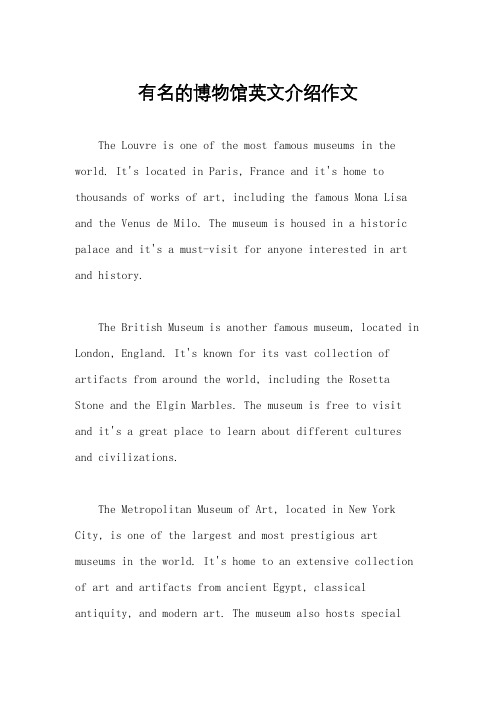
有名的博物馆英文介绍作文The Louvre is one of the most famous museums in the world. It's located in Paris, France and it's home to thousands of works of art, including the famous Mona Lisa and the Venus de Milo. The museum is housed in a historic palace and it's a must-visit for anyone interested in art and history.The British Museum is another famous museum, located in London, England. It's known for its vast collection of artifacts from around the world, including the Rosetta Stone and the Elgin Marbles. The museum is free to visit and it's a great place to learn about different cultures and civilizations.The Metropolitan Museum of Art, located in New York City, is one of the largest and most prestigious art museums in the world. It's home to an extensive collection of art and artifacts from ancient Egypt, classical antiquity, and modern art. The museum also hosts specialexhibitions and events throughout the year.The Hermitage Museum in St. Petersburg, Russia, is another famous museum with a rich history. It's housed in a grand palace and it's known for its impressive collectionof European art, including works by Rembrandt, Michelangelo, and Leonardo da Vinci. The museum also has a vastcollection of decorative arts and historical artifacts.The National Gallery in London is a renowned art museum that houses a rich collection of paintings from the 13th to the 19th centuries. It's located in Trafalgar Square andit's free to visit. The museum's collection includes works by famous artists such as Leonardo da Vinci, Vincent van Gogh, and Claude Monet.The Vatican Museums in Vatican City are a must-visitfor anyone interested in art and history. The museums are home to an extensive collection of art and artifacts collected by the popes over the centuries. Highlights ofthe collection include the Sistine Chapel, the Raphael Rooms, and the Gallery of Maps.。
不同类型的博物馆及其展陈特色英语作文
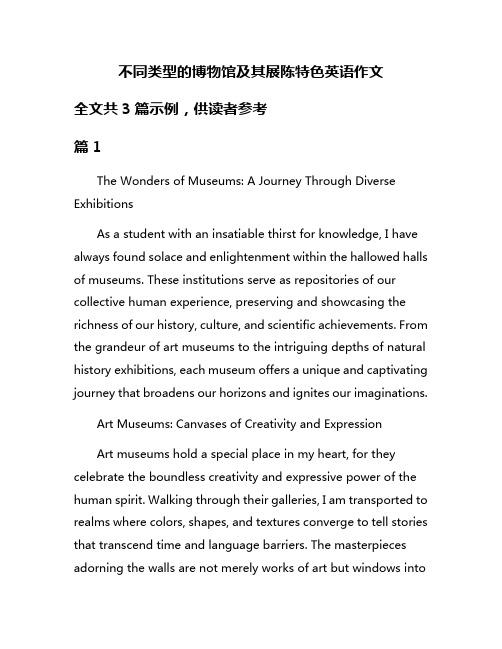
不同类型的博物馆及其展陈特色英语作文全文共3篇示例,供读者参考篇1The Wonders of Museums: A Journey Through Diverse ExhibitionsAs a student with an insatiable thirst for knowledge, I have always found solace and enlightenment within the hallowed halls of museums. These institutions serve as repositories of our collective human experience, preserving and showcasing the richness of our history, culture, and scientific achievements. From the grandeur of art museums to the intriguing depths of natural history exhibitions, each museum offers a unique and captivating journey that broadens our horizons and ignites our imaginations.Art Museums: Canvases of Creativity and ExpressionArt museums hold a special place in my heart, for they celebrate the boundless creativity and expressive power of the human spirit. Walking through their galleries, I am transported to realms where colors, shapes, and textures converge to tell stories that transcend time and language barriers. The masterpieces adorning the walls are not merely works of art but windows intothe souls of their creators, offering glimpses into the emotions, philosophies, and societal contexts that inspired them.One of my favorite art museums is the Metropolitan Museum of Art in New York City. Its vast collection spans continents and millennia, allowing visitors to explore the diverse artistic traditions of ancient civilizations and modern masters alike. From the enigmatic smile of the Mona Lisa to the vibrant brushstrokes of Van Gogh's "Starry Night," each exhibit invites us to ponder the complexities of human expression and the universal language of art.Natural History Museums: Unveiling the Marvels of NatureWhile art museums captivate the senses with human creativity, natural history museums unveil the wonders of the natural world in all its splendor. These institutions serve as windows into the intricate tapestry of life on our planet, showcasing the incredible diversity of flora and fauna, as well as the geological and evolutionary forces that have shaped our environment.The American Museum of Natural History in New York City is a true gem in this regard. Its renowned dinosaur exhibits transport visitors back millions of years, allowing us to marvel at the towering skeletons of these prehistoric giants and imaginethe world they inhabited. The museum's dioramas offer immersive experiences, recreating entire ecosystems with stunning realism, from the lush rainforests to the frozen tundras.Science and Technology Museums: Exploring the Frontiers of InnovationIn our ever-evolving world, science and technology museums play a crucial role in sparking curiosity and fostering an appreciation for the marvels of human ingenuity. These institutions serve as temples of knowledge, showcasing the latest breakthroughs and innovations that have revolutionized our lives and pushed the boundaries of what we thought possible.The Science Museum in London is a true testament to this spirit of exploration and discovery. Its interactive exhibits bring scientific concepts to life, allowing visitors to engage with cutting-edge technologies and witness firsthand the principles that govern our universe. From the exploration of outer space to the inner workings of the human body, this museum offers a captivating journey through the realms of science and technology.History Museums: Preserving the Tapestry of Human CivilizationHistory museums stand as guardians of our collective past, preserving the stories, artifacts, and legacies that have shaped the course of human civilization. These institutions serve as time capsules, transporting visitors through the annals of history and offering invaluable insights into the triumphs, struggles, and cultural richness of bygone eras.The British Museum in London is a true treasure trove of historical wonders, housing an astounding collection that spans millennia and encompasses artifacts from ancient civilizations across the globe. From the imposing Rosetta Stone to the intricate sculptures of ancient Greece and Rome, each exhibit tells a tale of human resilience, creativity, and the enduring quest for knowledge.Living History Museums: Immersive Experiences from the PastDistinct from traditional history museums, living history museums offer a truly immersive and interactive experience, transporting visitors back in time to witness and participate in the daily lives of past eras. These open-air museums recreate entire towns, villages, or historical settings, complete with costumed interpreters who bring the past to life through their portrayals and demonstrations.One such remarkable living history museum is Colonial Williamsburg in Virginia, USA. Stepping into its meticulously recreated 18th-century town, visitors are enveloped in the sights, sounds, and smells of colonial America. From watching skilled artisans at work to engaging in lively debates with historical figures, this museum offers a truly immersive experience that ignites the imagination and deepens our understanding of the past.Museums are not merely repositories of artifacts; they are gateways to knowledge, inspiration, and self-discovery. Whether exploring the realms of art, science, history, or living experiences, each museum offers a unique and captivating journey that enriches our lives and fosters a deeper appreciation for the wonders of our world. As a student, I am forever grateful for these institutions that nurture our intellectual curiosity and fuel our pursuit of understanding the complexities of human existence.篇2Museums - Gateways to the Past and FutureAs a student, I have always been fascinated by the wealth of knowledge and experiences that museums offer. From grandnational institutions to quirky local exhibitions, these treasure troves of history, art, and science never cease to captivate and educate. In this essay, I will explore the diverse array of museum types, each with its own unique exhibition features and storytelling approaches.Natural History MuseumsStepping into a natural history museum is like embarking on a journey through time, where the wonders of our planet's origins and evolution are unveiled. These museums are renowned for their extensive collections of fossils, minerals, and preserved specimens of flora and fauna. Immersive dioramas transport visitors to prehistoric landscapes, allowing them to glimpse into the lives of ancient creatures that once roamed the Earth.One of the standout features of natural history museums is their ability to bring extinct species back to life through meticulously reconstructed skeletons and lifelike models. Whether it's the towering skeleton of a Tyrannosaurus Rex or the delicate bones of an early hominid, these exhibits evoke a sense of awe and curiosity, prompting us to ponder our place in the grand tapestry of life.Art MuseumsArt museums are sanctuaries of creativity, where the human spirit is celebrated through a diverse array of artistic expressions. From classical masterpieces to cutting-edge contemporary installations, these institutions offer a window into the minds of artists across different eras and cultures.One of the most captivating aspects of art museums is their ability to curate thematic exhibitions that explore specific movements, periods, or artistic styles. Visitors can immerse themselves in the vibrant colors and bold brushstrokes of Impressionism, or contemplate the thought-provoking abstractions of modern art. Interactive displays and multimedia presentations often enhance these exhibitions, providing insights into the artists' techniques, inspirations, and the historical contexts in which their works were created.Science and Technology MuseumsIn an era of rapid technological advancements, science and technology museums play a vital role in fostering curiosity, innovation, and scientific literacy. These dynamic institutions showcase the wonders of scientific discoveries, technological breakthroughs, and their impact on our daily lives.Hands-on exhibits are a hallmark of science and technology museums, encouraging visitors to actively engage with conceptsand principles. Interactive displays, simulations, and demonstrations allow visitors to conduct experiments, manipulate variables, and witness scientific phenomena firsthand. From exploring the intricacies of DNA to marveling at the mechanics of a rocket engine, these museums make complex ideas accessible and engaging for learners of all ages.篇3Different Types of Museums and Their Unique Exhibition StylesMuseums are treasure troves of knowledge, culture, and history. As a student with an insatiable curiosity, I find myself frequently drawn to these institutions, each offering a unique perspective on the world around us. From art galleries that transport us through time with their masterpieces to natural history museums that showcase the wonders of our planet, the diversity of museums is truly remarkable. In this essay, I will explore the various types of museums and their distinct exhibition styles, highlighting the captivating experiences they offer.Art Museums: Gateways to Artistic BrillianceArt museums hold a special place in my heart, as they provide a window into the souls of artists from across the ages. These sanctuaries of creativity showcase a vast array of mediums, from the vibrant strokes of a painter's brush to the intricate sculptures that seem to defy the laws of physics. Walking through the halls of an art museum is like embarking on a journey through time, where each piece tells a story, evoking emotions and provoking thought.One of the most striking aspects of art museum exhibitions is their ability to transport visitors to different eras and cultures. The thoughtful curation of collections allows us to appreciate the evolution of artistic movements, from the Renaissance masterpieces of Michelangelo and Raphael to the bold strokes of the Impressionists and the avant-garde works of the Cubists. Immersing ourselves in these exhibitions is like peering into the minds of the artists themselves, gaining a deeper understanding of their motivations, techniques, and the societal influences that shaped their creations.Natural History Museums: Unraveling the Mysteries of Our PlanetIf art museums are gateways to human creativity, natural history museums are portals to the wonders of our natural world.These institutions offer a captivating journey through the intricate tapestry of life on Earth, from the earliest fossils to the diverse array of flora and fauna that inhabit our planet today.One of the most remarkable aspects of natural history museum exhibitions is their ability to bring the past to life. Towering dinosaur skeletons, meticulously reconstructed from ancient fossils, transport us back millions of years, allowing us to imagine what the Earth looked like during the age of these mighty creatures. Dioramas and lifelike displays recreate entire ecosystems, showcasing the intricate relationships between different species and their environments.But natural history museums are not just about the past; they also shed light on the present and future of our planet. Interactive exhibits on climate change, conservation efforts, and sustainable practices educate visitors on the pressing environmental challenges we face and inspire us to take action to protect our planet's fragile ecosystems.Science and Technology Museums: Celebrating Human IngenuityIn a world driven by rapid technological advancements, science and technology museums stand as beacons of human ingenuity and innovation. These institutions celebrate theremarkable achievements of scientists, engineers, and inventors, showcasing the groundbreaking discoveries and inventions that have shaped our modern world.One of the most engaging aspects of science and technology museum exhibitions is their hands-on approach. Interactive displays and immersive experiences allow visitors to actively participate in the learning process, fostering a deeper understanding and appreciation for scientific principles and technological marvels. From simulated space missions to virtual reality experiences that transport us to the depths of the ocean or the far reaches of the universe, these exhibitions ignite our curiosity and inspire us to explore the boundaries of human knowledge.Moreover, science and technology museums often showcase cutting-edge research and innovations, providing a glimpse into the future and the potential transformative impact of emerging technologies on our lives. From sustainable energy solutions to medical breakthroughs, these exhibitions challenge us to think critically about the role of science and technology in addressing global challenges and improving the human condition.Cultural and Anthropological Museums: Exploring the Tapestry of Human DiversityIn a world that is becoming increasingly interconnected, cultural and anthropological museums play a vital role in fostering understanding and appreciation for the rich tapestry of human diversity. These institutions offer a captivating journey through the traditions, beliefs, and ways of life of various cultures, both past and present.One of the most powerful aspects of cultural museum exhibitions is their ability to challenge preconceived notions and promote cross-cultural understanding. Through carefully curated displays of artifacts, clothing, art, and architectural elements, visitors gain insight into the customs, rituals, and belief systems that shape different societies. Interactive exhibits, such as recreated dwellings or immersive multimedia experiences, transport us to distant lands, allowing us to experience a glimpse of life through the eyes of others.Anthropological museums, on the other hand, delve deeper into the origins and evolution of human societies, shedding light on the intricate connections between cultural practices, environmental factors, and historical events. These exhibitions often feature archaeological finds, ancient tools and weapons, and reconstructions of early human settlements, providing afascinating glimpse into the lives of our ancestors and the foundations upon which modern civilizations were built.Historical Museums: Preserving the Collective MemoryHistorical museums serve as guardians of our collective memory, preserving the stories, artifacts, and records that shape our understanding of the past. These institutions offer a powerful journey through time, allowing us to witness pivotal moments in history and gain valuable insights into the events, individuals, and societal forces that have shaped the world we live in today.One of the most captivating aspects of historical museum exhibitions is their ability to bring history to life through immersive and multi-sensory experiences. From recreated battlefields and period-specific settings to interactive multimedia displays and first-hand accounts from eyewitnesses, these exhibitions transport visitors back in time, fostering a deeper emotional connection with the past.Moreover, historical museums often showcase rare and invaluable artifacts, such as ancient manuscripts, weapons, clothing, and personal belongings, providing tangible links to the lives and experiences of those who came。
介绍博物馆展品的英语作文
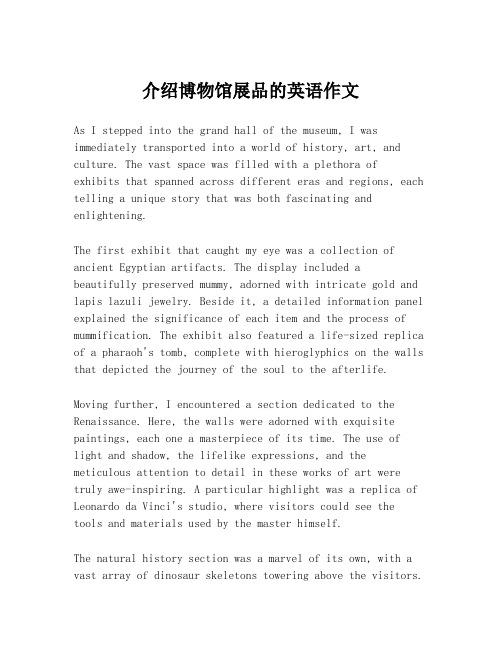
介绍博物馆展品的英语作文As I stepped into the grand hall of the museum, I was immediately transported into a world of history, art, and culture. The vast space was filled with a plethora ofexhibits that spanned across different eras and regions, each telling a unique story that was both fascinating and enlightening.The first exhibit that caught my eye was a collection of ancient Egyptian artifacts. The display included abeautifully preserved mummy, adorned with intricate gold and lapis lazuli jewelry. Beside it, a detailed information panel explained the significance of each item and the process of mummification. The exhibit also featured a life-sized replica of a pharaoh's tomb, complete with hieroglyphics on the walls that depicted the journey of the soul to the afterlife.Moving further, I encountered a section dedicated to the Renaissance. Here, the walls were adorned with exquisite paintings, each one a masterpiece of its time. The use of light and shadow, the lifelike expressions, and the meticulous attention to detail in these works of art were truly awe-inspiring. A particular highlight was a replica of Leonardo da Vinci's studio, where visitors could see thetools and materials used by the master himself.The natural history section was a marvel of its own, with a vast array of dinosaur skeletons towering above the visitors.The most impressive of these was a full-size Tyrannosaurus rex, its jaws open in a fearsome roar. Interactive displays allowed us to learn about the different species of dinosaurs, their habitats, and the evolution of life on Earth.In the modern art wing, abstract paintings and sculptures took center stage. The bold use of colors and shapes in these pieces was a stark contrast to the classical art I had seen earlier. An audio guide provided insights into the artists' intentions and the cultural context behind each piece, helping me appreciate the creativity and innovation that modern art represents.One of the most interactive exhibits was the science and technology section. Here, I had the opportunity toparticipate in hands-on experiments that demonstrated fundamental principles of physics and chemistry. A virtual reality experience allowed me to explore the surface of Mars, while a holographic display showed the inner workings of a human heart.As I left the museum, I felt a deep sense of gratitude for the opportunity to explore these exhibits. They not only provided me with a wealth of knowledge but also sparked my curiosity and inspired a newfound appreciation for the diverse and rich heritage of our world. The museum was truly a treasure trove of human achievement, and I couldn't wait to return and delve into more of its wonders.。
关于介绍博物馆的初中英语范文
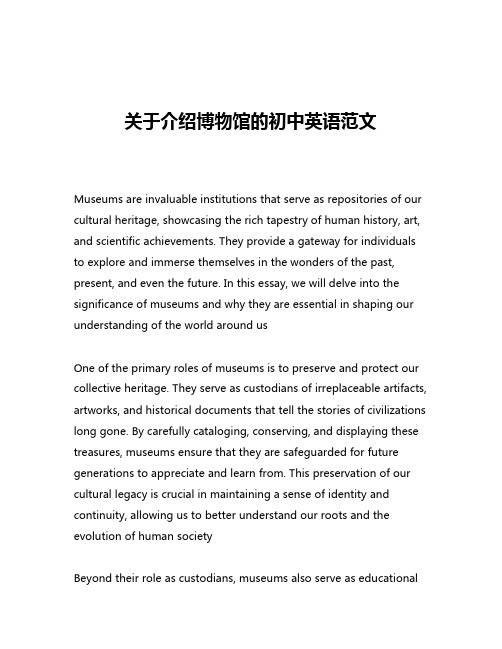
关于介绍博物馆的初中英语范文Museums are invaluable institutions that serve as repositories of our cultural heritage, showcasing the rich tapestry of human history, art, and scientific achievements. They provide a gateway for individuals to explore and immerse themselves in the wonders of the past, present, and even the future. In this essay, we will delve into the significance of museums and why they are essential in shaping our understanding of the world around usOne of the primary roles of museums is to preserve and protect our collective heritage. They serve as custodians of irreplaceable artifacts, artworks, and historical documents that tell the stories of civilizations long gone. By carefully cataloging, conserving, and displaying these treasures, museums ensure that they are safeguarded for future generations to appreciate and learn from. This preservation of our cultural legacy is crucial in maintaining a sense of identity and continuity, allowing us to better understand our roots and the evolution of human societyBeyond their role as custodians, museums also serve as educationalhubs, inspiring visitors to explore and expand their knowledge. Through carefully curated exhibits and interactive displays, museums provide a hands-on learning experience that engages the senses and stimulates the mind. Whether it's learning about ancient Egyptian hieroglyphics, marveling at the intricate workings of a Renaissance-era clock, or delving into the mysteries of the cosmos, museums offer a unique opportunity to bridge the gap between textbook knowledge and real-world understandingThe educational value of museums extends beyond the confines of the classroom. They serve as vital resources for students of all ages, providing opportunities for field trips, research, and specialized programs that complement and enrich the curriculum. By exposing young minds to the wonders of history, art, and science, museums play a crucial role in nurturing curiosity, critical thinking, and a lifelong love of learningMoreover, museums serve as hubs of cultural exchange and understanding. They showcase the diversity of human expression, from the awe-inspiring masterpieces of renowned artists to the intricate craftsmanship of indigenous cultures. By bringing people together to appreciate and celebrate these cultural treasures, museums foster a greater sense of global connectivity and mutual respect. They encourage visitors to step outside their own perspectives and gain a deeper appreciation for the sharedexperiences and unique perspectives that define the human experienceIn addition to their educational and cultural roles, museums also contribute to the economic and social well-being of their surrounding communities. They attract tourists from around the world, generating revenue and supporting local businesses. Furthermore, museums often serve as centers for community engagement, hosting events, workshops, and programs that bring people together, fostering a sense of belonging and civic prideHowever, the importance of museums extends beyond their immediate impact. They also play a vital role in shaping our collective memory and understanding of the past. By preserving and interpreting historical artifacts and narratives, museums help us make sense of the present and better prepare for the future. They serve as repositories of knowledge, inspiring scholars, artists, and innovators to build upon the foundations laid by those who came before themAs we navigate the complexities of the modern world, the role of museums becomes increasingly crucial. In an age of rapid technological advancement and globalization, these institutions serve as anchors, grounding us in the rich tapestry of human history and culture. They provide a space for contemplation, reflection, andthe exploration of diverse perspectives, reminding us of the shared humanity that unites us allIn conclusion, museums are not merely passive repositories of the past; they are dynamic, living institutions that shape our understanding of the world and our place within it. By preserving our cultural heritage, fostering education and cultural exchange, and contributing to the social and economic well-being of their communities, museums play an indispensable role in shaping the present and guiding us towards a more informed and enlightened future. As we continue to navigate the challenges and opportunities of the 21st century, the enduring significance of museums will undoubtedly remain a testament to the enduring human spirit and our collective desire to understand and celebrate the rich tapestry of our shared existence。
介绍有名博物馆英文作文

介绍有名博物馆英文作文The British Museum is one of the most renowned museums in the world, located in London, England. Established in 1753, it houses a vast and diverse collection of art and artifacts from all corners of the globe, spanning over two million years of human history and culture.The museum's collection is truly extraordinary, encompassing a wide range of disciplines including archaeology, anthropology, art history, and more. One ofits most famous exhibits is the Rosetta Stone, a keyartifact in deciphering ancient Egyptian hieroglyphs. Other highlights include the Elgin Marbles, ancient Greek sculptures that once adorned the Parthenon, and the Egyptian mummies, providing a glimpse into the beliefs and practices of ancient civilizations.The British Museum's galleries are organized thematically, allowing visitors to explore different aspects of human civilization. From the Ancient Near Eastto Asia, Africa, Europe, and the Americas, each section offers insights into the rich cultural heritage of various societies.Moreover, the museum regularly hosts special exhibitions, showcasing treasures from its own collection as well as loans from other institutions around the world. These exhibitions cover a wide range of topics, from ancient civilizations to contemporary art, providing visitors with opportunities to delve deeper into specific areas of interest.In addition to its exhibitions, the British Museum also offers a range of educational programs and resources for visitors of all ages. From guided tours and lectures to workshops and online resources, there are numerous opportunities for learning and engagement.The architecture of the British Museum itself is also noteworthy, with its iconic Greek Revival facade and the stunning glass-roofed Great Court at its center. Designed by architect Sir Robert Smirke in the 19th century andlater renovated by Sir Norman Foster in the early 21st century, the museum seamlessly blends historic grandeur with modern amenities.Overall, the British Museum is not only a treasure trove of human history and culture but also a vibrant hub of learning and exploration. Whether you're a history buff, an art enthusiast, or simply curious about the world, a visit to this iconic institution is sure to be a rewarding experience.。
如何在为广西民族博物馆设一个展厅英语作文
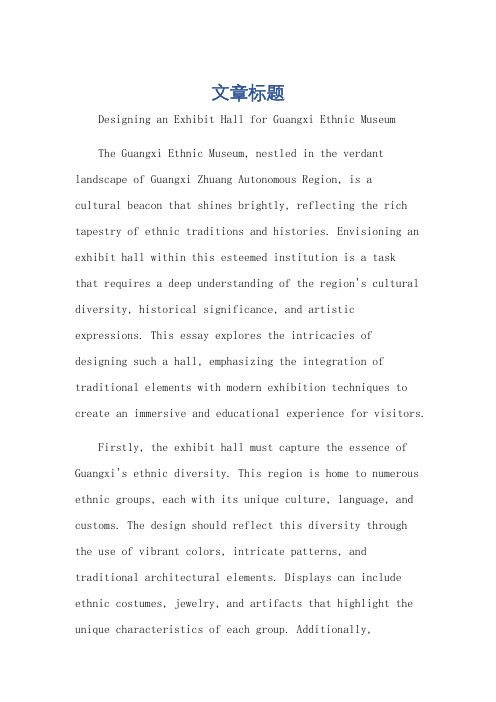
文章标题Designing an Exhibit Hall for Guangxi Ethnic MuseumThe Guangxi Ethnic Museum, nestled in the verdant landscape of Guangxi Zhuang Autonomous Region, is acultural beacon that shines brightly, reflecting the rich tapestry of ethnic traditions and histories. Envisioning an exhibit hall within this esteemed institution is a taskthat requires a deep understanding of the region's cultural diversity, historical significance, and artistic expressions. This essay explores the intricacies of designing such a hall, emphasizing the integration of traditional elements with modern exhibition techniques to create an immersive and educational experience for visitors. Firstly, the exhibit hall must capture the essence of Guangxi's ethnic diversity. This region is home to numerous ethnic groups, each with its unique culture, language, and customs. The design should reflect this diversity throughthe use of vibrant colors, intricate patterns, andtraditional architectural elements. Displays can include ethnic costumes, jewelry, and artifacts that highlight the unique characteristics of each group. Additionally,interactive elements such as audio-visual presentations and touch screens can provide further insights into the ethnic cultures, allowing visitors to engage with the exhibits in a more immersive manner.Secondly, historical narratives are integral to the exhibit hall's design. Guangxi has a rich history that spans thousands of years, encompassing various epochs and significant events. The hall should present a chronology of these historical developments, showcasing artifacts, historical documents, and reconstructions that illustrate the region's evolution. This will not only educate visitors about the past but also foster a sense of pride and connection to the region's heritage.Moreover, the exhibit hall should feature a focus on artistic expressions. Guangxi is renowned for its vibrant folk arts, including embroidery, pottery, and music. The design should incorporate these artistic elements, displaying examples of traditional crafts and performances. This will not only showcase the region's artistic talents but also provide visitors with an appreciation for the beauty and creativity inherent in ethnic cultures.Furthermore, the exhibit hall should be designed with accessibility and inclusivity in mind. This includes providing signage in multiple languages, ensuring that displays are at appropriate heights for all visitors, and incorporating tactile elements for those who may not be able to see the exhibits. Additionally, the layout of the hall should be intuitive and easy to navigate, with clear signage and maps to guide visitors through the exhibits. Finally, the exhibit hall should be a dynamic space that can adapt to changing exhibitions and themes. This flexibility will allow the museum to showcase different aspects of Guangxi's ethnic cultures and histories over time, keeping the exhibit hall fresh and engaging for repeat visitors.In conclusion, designing an exhibit hall for the Guangxi Ethnic Museum is a complex yet rewarding task. It requires a meticulous balance of traditional elements, historical narratives, artistic expressions, and modern exhibition techniques. By capturing the essence of Guangxi's ethnic diversity, presenting historical developments, highlighting artistic talents, and ensuringaccessibility and inclusivity, the exhibit hall willprovide an immersive and educational experience forvisitors, fostering a deeper understanding and appreciation of the region's rich cultural heritage.**为广西民族博物馆设计展厅**广西民族博物馆,坐落于风景如画的广西壮族自治区,是一座文化灯塔,闪耀着民族传统和历史的多彩光芒。
